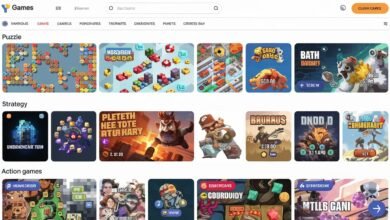Exploring Geometry Spot Games: Fun and Engaging Ways to Sharpen Your Skills

Introduction to Geometry Spot Games
Geometry spot games are interactive and engaging activities designed to enhance spatial awareness and geometric understanding. These games serve to reinforce essential mathematical concepts by allowing players to identify, analyze, and manipulate geometric shapes in various settings. By blending education with play, geometry spot games create an enjoyable learning atmosphere that can benefit learners of all ages.
The primary purpose of these games is to develop critical thinking and problem-solving skills. Participants are often tasked with spotting differences between geometric figures or completing intricate patterns that require acute attention to detail and a solid grasp of geometric principles. This cognitive engagement fosters not only mathematical proficiency but also boosts concentration and visual perception.
In recent years, the popularity of geometry spot games has surged, particularly within educational institutions and online platforms. Teachers increasingly recognize the value of incorporating game-based learning into their curricula, viewing these activities as effective tools for promoting student engagement and enhancing retention of geometric concepts. The integration of technology has further expanded the accessibility of these games, allowing learners to engage with geometry in stimulating and interactive formats that draw them into the content.
Additionally, geometry spot games come in various forms, including digital applications, printable worksheets, and interactive classroom activities. They cater to diverse learning styles and can be adapted to suit different age groups and skill levels. This flexibility ensures that learners can engage meaningfully, regardless of their prior knowledge of geometry. As awareness of these benefits continues to grow, it is anticipated that geometry spot games will remain an integral part of modern educational practices, effectively marrying fun and learning.
The Importance of Geometry in Education
Geometry plays a pivotal role in the educational curriculum, serving as a foundation for various other mathematical concepts. Understanding geometric principles equips students with critical skills that extend beyond the classroom. Mastering geometry not only enhances mathematical proficiency but also significantly contributes to the development of problem-solving abilities and logical reasoning. These skills are essential not only in academic settings but also in everyday life situations.
One of the first benefits of mastering geometric concepts is improved spatial awareness. A solid understanding of geometry allows students to visualize and manipulate shapes in their minds, which is crucial when tackling real-world problems and engaging in activities such as architecture and engineering. Geometry spot games can reinforce this spatial reasoning, making learning engaging and enjoyable. Through practice in these games, students can develop a stronger grasp of the properties and relations of shapes, which further enhances their mathematical competence.
Additionally, geometry serves as a gateway to higher-level math. Topics such as algebra and calculus are often intertwined with geometric concepts, making it essential for students to have a strong geometric background. The analytical skills developed through studying geometry also foster logical thinking, which is applicable across various subjects and disciplines. When students engage with geometry spot games, they not only practice these concepts in a playful manner but also gain the confidence needed to tackle more complex mathematical challenges in the future.
Furthermore, mastering geometry has implications beyond academic performance. It nurtures critical thinking and innovation, essential skills in any career path. Understanding geometric principles can empower students to approach problems from multiple angles, enhancing their ability to devise effective solutions in both professional and personal contexts. Overall, the significance of geometry in education cannot be overstated, as it lays the groundwork for comprehensive mathematical understanding and equips learners with invaluable life skills.
Types of Geometry Spot Games
Geometry spot games encompass a diverse array of playful and educational tools designed to enhance spatial reasoning and geometric understanding. These games can be broadly categorized into three main types: puzzles, interactive online games, and printable worksheets.
Puzzles represent a classic form of geometry spot games that engage individuals through tactile and visual challenges. For example, jigsaw puzzles that incorporate geometric shapes require players to fit pieces together based on their spatial properties. Geometric tangram puzzles allow players to form various shapes using a specific number of pieces, fostering creativity and critical thinking. These hands-on activities not only promote learning but also provide a stimulating challenge that reinforces geometry concepts.
Another exciting category includes interactive online games, which have gained popularity in recent years. Many educational websites offer games that enhance geometry skills through engaging gameplay. For instance, platforms that feature geometric transformation games allow students to manipulate shapes and see the effects of translation, rotation, and reflection in real-time. Additionally, online quizzes and competitions can motivate learners by providing instant feedback and fostering a sense of achievement. These interactive tools often include levels of difficulty, catering to a range of ages and skill levels.
Finally, printable worksheets provide a versatile option for those wanting to practice geometry concepts in a structured manner. Teachers and parents can find countless worksheets that cover topics such as identifying shapes, calculating area and perimeter, and solving geometry puzzles. These worksheets can easily be used in classrooms or at home, allowing for flexible learning opportunities. Moreover, incorporating fun activities, such as coloring geometric patterns or solving riddles rooted in geometry, creates an enjoyable practice environment.
In sum, the variety of geometry spot games available, ranging from puzzles to interactive online platforms and printable worksheets, serves to create enjoyable learning experiences while effectively promoting geometry skills. Each type emphasizes different learning styles and preferences, allowing individuals to find the methods that best suit their needs.
Benefits of Playing Geometry Spot Games
Engaging in geometry spot games offers a plethora of benefits that extend beyond mere entertainment. One of the most notable advantages is the enhancement of spatial awareness. As players navigate through various geometric shapes and patterns, they develop an acute ability to visualize and manipulate objects in a three-dimensional space. This heightened spatial awareness is not only essential for academic pursuits in subjects like mathematics and science, but it also plays a vital role in everyday activities such as navigation and interior design.
Furthermore, geometry spot games are instrumental in improving critical thinking skills. The challenge of identifying and differentiating between geometric figures requires players to employ analytical reasoning. As they assess their options and strategies, they engage in problem-solving, which ultimately sharpens their analytical abilities. This critical thinking practice is invaluable for students and professionals alike, as it encourages a mindset focused on logical reasoning and effective decision-making.
Another beneficial aspect of playing geometry spot games is the stimulation of creativity. By exposing players to diverse geometric configurations, these games allow individuals to explore innovative ideas and concepts. This creative engagement not only aids in developing artistic skills but also fosters an environment in which unconventional thinking is encouraged. This characteristic is crucial in our rapidly evolving world, where creative solutions are increasingly sought after in various fields.
In addition to individual benefits, geometry spot games also promote teamwork and collaboration among participants. Many of these games are designed for multiple players, allowing friends, family, or classmates to work together to overcome challenges. This collaborative aspect cultivates communication skills and strengthens relationships, as players learn to share ideas and strategies in a supportive atmosphere. Consequently, the benefits of geometry spot games extend to social development, making them a well-rounded tool for both academic and personal growth.
How to Incorporate Geometry Spot Games into Learning
Incorporating geometry spot games into educational settings can significantly enhance students’ understanding of geometric concepts while making learning enjoyable. Here are some practical tips and strategies for educators and parents to effectively utilize these games in various learning environments.
Firstly, consider integrating technology into the learning process. There are numerous online platforms and applications that offer interactive geometry spot games. These digital tools not only provide a visually engaging experience but also allow for immediate feedback, which is vital for effective learning. Educators can encourage students to play these games on tablets or computers during designated periods, facilitating a self-paced learning approach that caters to individual skill levels.
Secondly, fostering group activities can amplify the learning experience. Geometry spot games can be transformed into collaborative tasks where students work in pairs or small teams. For example, educators could organize a geometry scavenger hunt, where groups use geometry spot games to identify and label geometric shapes in the classroom or school environment. This cooperative learning strategy promotes problem-solving skills, communication, and teamwork while reinforcing geometric concepts in a practical context.
Furthermore, individual practice remains an essential aspect of mastering geometry. Parents can support this by introducing offline geometry spot games, such as puzzle books, worksheets, or board games that focus on geometric principles. Integrating these activities into daily routines, such as during family game night, creates a fun atmosphere conducive to learning.
Overall, by implementing these strategies—leveraging technology, promoting group activities, and facilitating individual practice—educators and parents can effectively integrate geometry spot games into learning environments. This approach not only helps reinforce geometric concepts but also cultivates a strong foundation for students’ future mathematical endeavors.
Popular Geometry Spot Games to Try
Geometry spot games have gained immense popularity for their engaging blend of fun and educational value. These games are designed to sharpen players’ spatial awareness, problem-solving skills, and geometric understanding. Here, we will explore some popular geometry spot games available online and in app stores, suitable for various age groups and skill levels.
One notable game is Geometry Dash, a paid platformer that challenges players to navigate through various levels with geometric shapes while synchronizing to music. This game is particularly appealing to older children and teenagers, as it demands quick reflexes and spatial reasoning. Players can also customize their characters, adding a personal touch to the gameplay experience.
Another great option is Geoboard, a free app that encourages users to create shapes using virtual rubber bands on a peg board. This game is ideal for younger children, as it introduces basic geometric concepts while providing a platform for creative expression. By manipulating shapes and learning to form different polygons, users develop a strong foundation in geometry.
For those looking for a more interactive experience, Symmetry Shuffle is highly recommended. This game leads players through an array of challenges that focus on symmetry and transformation of shapes, making it accessible for a diverse audience, including primary school students and adults. Additionally, the multiplayer feature allows friends or family to collaborate or compete, heightening the enjoyment factor.
Finally, Math Playground offers a variety of geometry spot games that target elementary school students. These games cover essential geometric concepts through fun puzzles and interactive scenarios. By incorporating gameplay, children can enhance their understanding of geometry without the pressure of traditional learning environments.
Overall, the diversity of geometry spot games available means that learners of all ages can engage and enjoy while developing crucial math skills.
Challenges and Tips for Playing Geometry Spot Games
Engaging in geometry spot games can be an enjoyable and productive way to enhance one’s mathematical abilities. However, players may encounter specific challenges that can impede their progress and affect their overall experience. Understanding these challenges and employing effective strategies can lead to improvement and a more rewarding experience.
One common challenge players face is frustration when they struggle to find the correct answers or identify geometric shapes quickly. This frustration can stem from an overwhelming sense of competition or a desire for perfection. A useful strategy for overcoming this hurdle is to approach each game with a mindset focused on learning rather than solely winning. Celebrate small victories and recognize that mistakes serve as a crucial part of the learning process. By treating errors as opportunities for growth, players can maintain motivation and enhance their performance in geometry spot games.
Another difficulty often encountered is the tendency to rush through challenges without fully understanding the geometrical concepts at play. To counteract this, players are encouraged to take their time and reflect on the relationships between shapes and their attributes. Analyzing each game thoughtfully can lead to a deeper understanding of geometry, thereby improving future performance. Breaking down complex problems into smaller, manageable parts can further ease the cognitive load and facilitate better decision-making.
Additionally, collaborating with peers while playing geometry spot games can provide valuable insights and foster a growth mindset. Discussing strategies and sharing experiences can contribute to a positive learning environment, helping players remain engaged and motivated. Building a network of fellow enthusiasts can also offer encouragement, making challenges seem less daunting.
Ultimately, recognizing common obstacles faced in geometry spot games and employing effective strategies enhances not only the gaming experience but also contributes to the development of critical thinking and problem-solving skills.
Success Stories: How Geometry Spot Games Have Helped Learners
Numerous teachers and students alike have attested to the positive influence of geometry spot games in educational settings. These games not only make learning geometry enjoyable but also foster a deeper understanding of geometric concepts. One compelling testimonial comes from a middle school teacher who integrated geometry spot games into her curriculum. She noted a significant increase in her students’ engagement during math lessons. As a result, grade averages for geometry assessments improved by over 15%. Students reported that the interactive nature of the games made the subject more approachable and less intimidating.
Similarly, a high school student shared his experience of using geometry spot games during a challenging semester. Initially struggling with geometric proofs and theorems, he found that the visuals and interactive challenges presented in these games helped clarify complex ideas. By the end of the term, not only had his comprehension improved, but he had also developed a newfound appreciation for geometry. His confidence was reflected in his final project, where he applied geometric concepts in a real-world context, earning commendations from his teacher.
In another case, an after-school program dedicated to at-risk youth incorporated geometry spot games to enhance their math skills. The program coordinator reported that participation in these activities led to a 30% increase in student attendance and engagement. Students who once viewed math as a tedious subject began to approach it with enthusiasm, eager to participate in the game-based learning approach. This initiative not only helped in academic performance but also fostered social interactions among peers, creating a supportive learning environment.
These success stories exemplify how geometry spot games can significantly enhance the learning experience. They illustrate the potential to transform students’ attitudes towards mathematics, making it an exciting and fruitful endeavor.
Conclusion: The Future of Geometry Spot Games
As we have explored throughout this article, geometry spot games serve as a vital educational resource that encourages individuals to enhance their spatial reasoning and analytical skills in an engaging manner. These interactive games have evolved significantly, integrating various teaching methodologies to appeal to diverse learning styles. This evolution not only makes geometry more accessible but also more entertaining for learners of all ages.
Looking ahead, the future of geometry spot games appears promising, particularly with the rapid advancements in technology. With the advent of augmented reality (AR) and virtual reality (VR), the potential to create immersive environments for geometry learning is indeed exciting. Imagine a geometry spot game where players can physically manipulate geometric shapes in a virtual space, thereby reinforcing their understanding of concepts such as symmetry, congruence, and transformations. Such innovations could transform traditional learning paradigms, allowing users to visualize and interact with complex geometric forms in unprecedented ways.
Moreover, the incorporation of artificial intelligence (AI) within these games can personalize learning experiences, tailoring challenges to the individual skill levels of players. This adaptability could foster a more effective learning environment, motivating users to engage with geometry in a way that best suits their progress. In addition, the integration of collaborative features within geometry spot games can promote teamwork and communication skills among players, which are essential in the modern educational landscape.
To sum up, as educational tools, geometry spot games are poised to benefit significantly from ongoing technological innovations. These advancements will likely lead to enhanced gameplay and richer learning experiences, fostering a more profound appreciation for geometry. As we embrace these changes, the future of geometry education looks bright, promising fun and engaging avenues for learners everywhere.
Visit xpzone.space, nextlevelgaming.space, gameverses.space, labonko.space, techzinews.co.uk, famousparenting.fun, joystickjunkie.fun, xpboost.space, theguilds.space, spawnpoint.space, levelupblog.space, pixelplanets.space, pixeldiary.fun, playreview.fun, gametalks.fun, nextlevelz.fun, beyonddaily.space, souldraft.space, curiouscorner.space, metavoicez.space, mycreatives.space, thoughtorbit.fun, wordplayground.fun, nextsthing.fun, ideasprout.fun, wanderink.fun, tagesfaktens.de, wissensheute.de, randomgiantnet.com, mashe.de, fokusaufleben.de, lebeninfokus.de, ecrypto1.site, guestinmagazine.co.uk, doms2cents.fun, blazejournal.co.uk, uplindon.space, usajournal.co.uk, bravooz.blog, nexoraa.fun, colpy.de, techzeiten.de, zukunftinfo.de, trendforbes.com, thecelebritygossip.blog, happagappa.blog, kakupress.site.
You May Also Read This Usadigitalhub.



